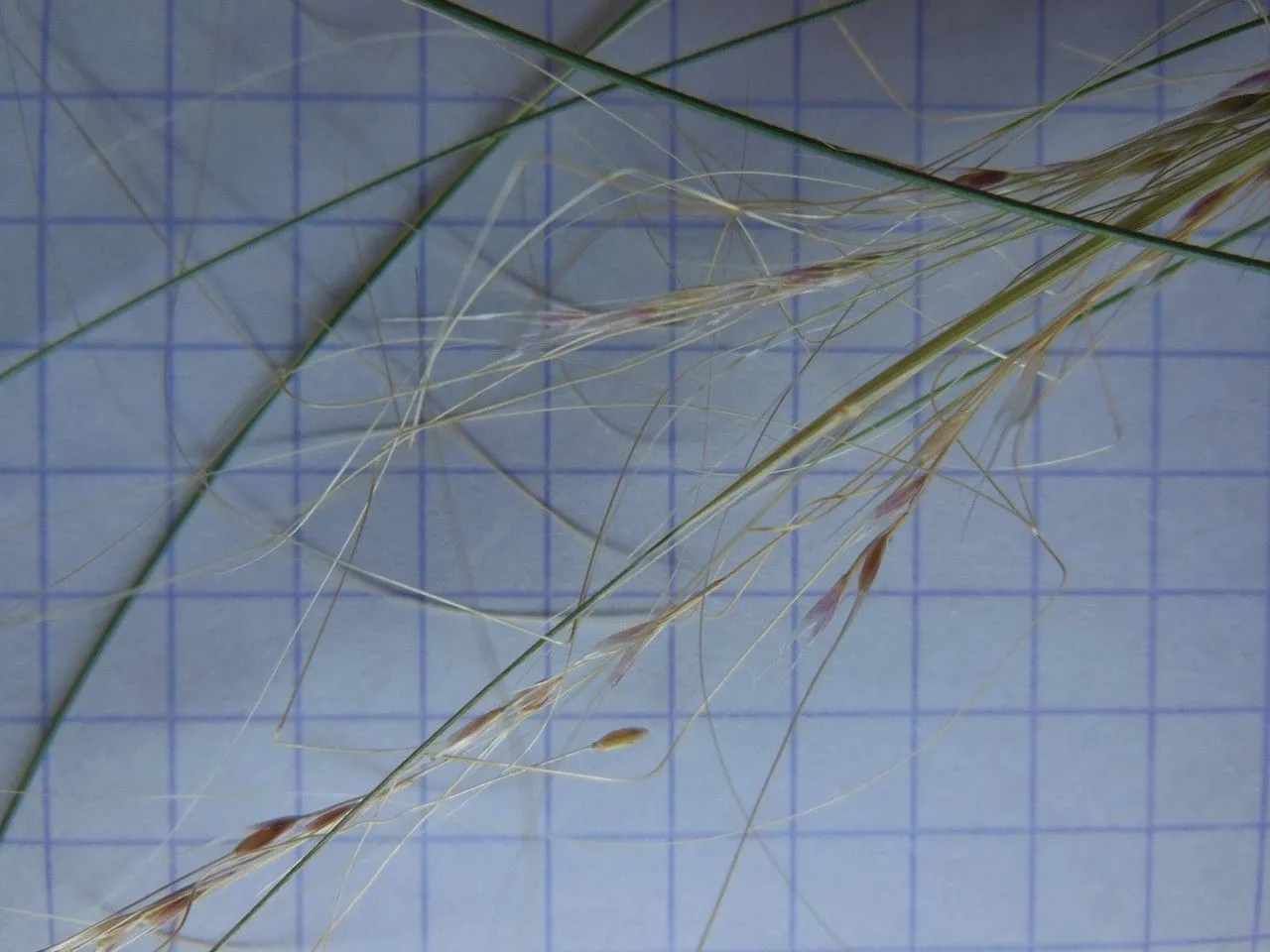
Author: L.
Bibliography: Sp. Pl. ed. 2: 116 (1762)
Year: 1762
Status: accepted
Rank: species
Genus: Stipa
Vegetable: False
Observations: Europe to N. China and Himalaya
Dwarf feather grass, scientifically known as Stipa capillata, is a versatile perennial plant admired for its ornamental qualities. A member of the Poaceae family, this grass has garnered attention since its formal description by Linnaeus in the 1762 edition of “Species Plantarum.” It thrives across a broad geographical range, extending from Europe to Northern China and the Himalayas, indicating its adaptability to varying climates and terrains.
Characterized by its delicate, wispy foliage, Dwarf feather grass earns its common name due to its feathery, soft-textured appearance. The plant typically creates a graceful, airy effect in garden landscapes, swaying gently with the breeze and adding movement to static settings. Ideal for both formal and informal garden designs, this ornamental grass complements a wide variety of plant companions.
Beyond its visual appeal, Stipa capillata is robust and relatively low-maintenance. It prefers well-drained soils and can thrive in conditions ranging from full sun to partial shade. The grass is especially tolerant of drought, making it an excellent choice for xeriscaping and sustainable gardening practices. Resistant to most pests and diseases, Dwarf feather grass further solidifies its reputation as a reliable and attractive garden plant.
In addition to its horticultural uses, this species has ecological benefits, providing habitat and food for various wildlife in its native regions. Its extensive root system helps in soil stabilization, preventing erosion and contributing to soil health.
Whether used as a centerpiece in a garden bed, an accent in a rock garden, or a filler in mixed perennial borders, Dwarf feather grass proves to be a valuable asset in landscaping projects. Its timeless elegance and adaptability ensure it remains a popular choice among gardeners and landscape architects alike.
Deu: haar-federgras, haar-pfriemengras
Swe: finbladigt fjädergräs
Lav: matveida kaviļa
En: Dwarf feather grass, Dwarf feathergrass, Hairy feather grass, Hairy feathergrass
Ar: عذم شعري
Bg: Влакновидно коило
Ca: Estipa capil·lada
Zh: 针茅
Cs: Kavyl vláskovitý
Da: Hårtotfjergræs
Et: Juus-stepirohi
Fr: Stipe capillaire, Stipe chevelue, Plumet chevelue
De: Büschelhaargras, Haar-Federgras (Haarfedergras), Haar-Pfriemengras (Haarpfriemengras), Haar-Pfriemengras, Haar-Federgras
Hu: Kunkorgó árvalányhaj
It: Lino delle fate capillare
Kk: Садақбоз қау
Lv: Matveida kaviļa
Fa: استپی موئین
Pl: Ostnica włosowata
Ru: Ковыль-волосатик
Sr: Длакаво ковиље
Sv: Finbladigt fjädergräs
Uk: Ковила волосиста
© copyright of the Board of Trustees of the Royal Botanic Gardens, Kew.
© copyright of the Board of Trustees of the Royal Botanic Gardens, Kew.
© copyright of the Board of Trustees of the Royal Botanic Gardens, Kew.
Taken Jul 13, 2015 by Tela Botanica − Dominique REMAUD (cc-by-sa)
Taken Jul 13, 2015 by Tela Botanica − Dominique REMAUD (cc-by-sa)
Taken Jan 21, 2021 by Jordan Wegberg (cc-by-sa)
Taken Sep 15, 2022 by Blue Bottle (cc-by-sa)
Taken Sep 7, 2022 by Anne-Marie Lanco (cc-by-sa)
Taken Feb 20, 2022 by Beate Liebold (cc-by-sa)
Taken Jan 1, 1970 by Photoflora – L’Abbé COSTE (©)
Taken Aug 15, 2014 by Photoflora – Benoit BOCK (©)
Taken Jul 13, 2015 by Tela Botanica − Dominique REMAUD (cc-by-sa)
Taken Sep 9, 2018 by Tela Botanica − Jean-Claude Bouzat (cc-by-sa)
Taken Jul 13, 2015 by Tela Botanica − Dominique REMAUD (cc-by-sa)
Taken Jul 13, 2015 by Tela Botanica − Dominique REMAUD (cc-by-sa)
Taken Jul 13, 2015 by Tela Botanica − Dominique REMAUD (cc-by-sa)
Taken May 21, 2020 by Carlos Villasante (cc-by-sa)
Taken May 21, 2020 by Carlos Villasante (cc-by-sa)
Taken Oct 11, 2022 by John Walsh (cc-by-sa)
Taken Aug 15, 2005 by Photoflora – Jean-Luc TASSET (©)
Taken Jul 13, 2015 by Tela Botanica − Dominique REMAUD (cc-by-sa)
Taken Jul 13, 2015 by Tela Botanica − Dominique REMAUD (cc-by-sa)
Taken Feb 13, 2019 by Tela Botanica − Genevieve Botti (cc-by-sa)
Taken Sep 18, 2015 by Tela Botanica − Jean-Luc Gorremans (cc-by-sa)
Taken Jul 13, 2015 by Tela Botanica − Dominique REMAUD (cc-by-sa)
Taken Sep 25, 2017 by Tela Botanica − Genevieve BOTTI (cc-by-sa)
Taken Aug 13, 2019 by Jorge Jorge Freitas (cc-by-sa)
Growth habit: Graminoid
Family: Myrtaceae Author: (F.Muell.) K.D.Hill & L.A.S.Johnson Bibliography: Telopea 6: 402 (1995) Year: 1995 Status:…
Family: Rubiaceae Author: Pierre ex A.Froehner Bibliography: Notizbl. Bot. Gart. Berlin-Dahlem 1: 237 (1897) Year:…
Family: Sapindaceae Author: Koidz. Bibliography: J. Coll. Sci. Imp. Univ. Tokyo 32(1): 38 (1911) Year:…
Family: Asteraceae Author: A.Gray Bibliography: Pacif. Railr. Rep.: 107 (1857) Year: 1857 Status: accepted Rank:…
Family: Fabaceae Author: Medik. Bibliography: Vorles. Churpfälz. Phys.-Ökon. Ges. 2: 398 (1787) Year: 1787 Status:…
Family: Aspleniaceae Author: (Cav.) Alston Bibliography: Bull. Misc. Inform. Kew 1932: 309 (1932) Year: 1932…